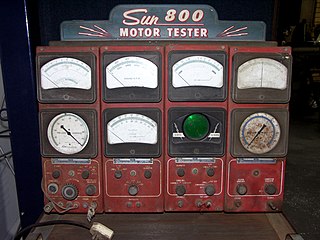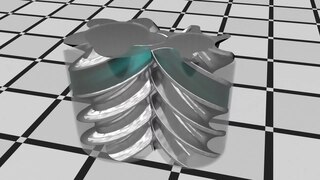
A turbocharger, colloquially known as a turbo, is a turbine-driven, forced induction device that increases an internal combustion engine's efficiency and power output by forcing extra compressed air into the combustion chamber. This improvement over a naturally aspirated engine's power output is because the compressor can force more air—and proportionately more fuel—into the combustion chamber than atmospheric pressure alone.

In engineering, the Miller cycle is a thermodynamic cycle used in a type of internal combustion engine. The Miller cycle was patented by Ralph Miller, an American engineer, US patent 2817322 dated Dec 24, 1957. The engine may be two- or four-stroke and may be run on diesel fuel, gases, or dual fuel.

An aircraft engine, often referred to as an aero engine, is the power component of an aircraft propulsion system. Most aircraft engines are either piston engines or gas turbines, although in recent years many small UAVs have used electric motors.

A four-strokeengine is an internal combustion (IC) engine in which the piston completes four separate strokes while turning the crankshaft. A stroke refers to the full travel of the piston along the cylinder, in either direction. The four separate strokes are termed:
- Intake: Also known as induction or suction. This stroke of the piston begins at top dead center (T.D.C.) and ends at bottom dead center (B.D.C.). In this stroke the intake valve must be in the open position while the piston pulls an air-fuel mixture into the cylinder by producing vacuum pressure into the cylinder through its downward motion. The piston is moving down as air is being sucked in by the downward motion against the piston.
- Compression: This stroke begins at B.D.C, or just at the end of the suction stroke, and ends at T.D.C. In this stroke the piston compresses the air-fuel mixture in preparation for ignition during the power stroke (below). Both the intake and exhaust valves are closed during this stage.
- Combustion: Also known as power or ignition. This is the start of the second revolution of the four stroke cycle. At this point the crankshaft has completed a full 360 degree revolution. While the piston is at T.D.C. the compressed air-fuel mixture is ignited by a spark plug or by heat generated by high compression, forcefully returning the piston to B.D.C. This stroke produces mechanical work from the engine to turn the crankshaft.
- Exhaust: Also known as outlet. During the exhaust stroke, the piston, once again, returns from B.D.C. to T.D.C. while the exhaust valve is open. This action expels the spent air-fuel mixture through the exhaust valve.

An intercooler is a mechanical device used to cool a gas after compression. Compressing a gas increases its internal energy which in turn raises its temperature and reduces its density. An intercooler typically takes the form of a heat exchanger that removes waste heat in a gas compressor. Intercoolers have a variety of applications, and can be found in air compressors, air conditioners, refrigeration, and gas turbines, and automotive engines, for example. They are widely known as an air-to-air or air-to-liquid cooler for forced induction internal combustion engines, used to improve volumetric efficiency. This is accomplished by increasing intake air density through nearly constant pressure cooling.

The Roots-type blower is a positive displacement lobe pump which operates by pumping a fluid with a pair of meshing lobes resembling a set of stretched gears. Fluid is trapped in pockets surrounding the lobes and carried from the intake side to the exhaust. The most common application of the Roots-type blower has been as the induction device on two-stroke diesel engines, such as those produced by Detroit Diesel and Electro-Motive Diesel. Roots-type blowers are also used to supercharge Otto cycle engines, with the blower being driven from the engine's crankshaft via a toothed or V-belt, a roller chain or a gear train.
A centrifugal supercharger is a specialized type of supercharger that makes use of centrifugal force in order to push additional air into an engine. Increased airflow into an engine allows the engine to burn more fuel, which results in increased power output of the engine. Centrifugal superchargers are generally attached to the front of the engine via a belt-drive or gear-drive from the engine's crankshaft.

Engine tuning is the adjustment or modification of the internal combustion engine or Engine Control Unit (ECU) to yield optimal performance and increase the engine's power output, economy, or durability. These goals may be mutually exclusive; an engine may be de-tuned with respect to output power in exchange for better economy or longer engine life due to lessened stress on engine components.

A naturally aspirated engine, also known as a normally aspirated engine, is an internal combustion engine in which air intake depends solely on atmospheric pressure and does not have forced induction through a turbocharger or a supercharger. Many sports cars specifically use naturally aspirated engines to avoid turbo lag.
Forced induction is the process of delivering compressed air to the intake of an internal combustion engine. A forced induction engine uses a gas compressor to increase the pressure, temperature and density of the air. An engine without forced induction is considered a naturally aspirated engine.
The anti-lag system (ALS) is a method of reducing turbo lag or effective compression used on turbocharged engines to minimize turbo lag on racing or performance cars. It works by delaying the ignition timing very slightly to balance an inherent loss in combustion efficiency with increased pressure at the charging side of the turbo. This is achieved as a small amount of fuel/air mixture escapes through the exhaust valves and combusts in the hot exhaust manifold spooling the turbocharger creating higher usable pressure.
Twincharger refers to a compound forced induction system used on some piston-type internal combustion engines. It is a combination of an exhaust-driven turbocharger and a mechanically driven supercharger, each mitigating the weaknesses of the other. A mechanically driven supercharger offers exceptional response and low-rpm performance as it does not rely on pressurization of the exhaust manifold. A turbocharger sized to move a large volume of air tends to respond slowly to throttle input while a smaller, faster-responding turbo may fail to deliver sufficient volume through an engine's upper RPM range. The unacceptable lag time endemic to a large turbocharger is effectively neutralized when combined with a supercharger which tends to generate substantial boost pressure much faster in response to throttle input. The end result being a zero-lag powerband with high torque at lower engine speeds and increased power at the upper end. Twincharging is therefore desirable for small-displacement motors, especially those with a large operating rpm, since they can take advantage of an artificially broad torque band over a large speed range.
Variable compression ratio is a technology to adjust the compression ratio of an internal combustion engine while the engine is in operation. This is done to increase fuel efficiency while under varying loads. Variable compression engines allow the volume above the piston at top dead centre to be changed. Higher loads require lower ratios to increase power, while lower loads need higher ratios to increase efficiency, i.e. to lower fuel consumption. For automotive use this needs to be done as the engine is running in response to the load and driving demands. The 2019 Infiniti QX50 is the first commercially available vehicle that uses a variable compression ratio engine.

A rotary-screw compressor is a type of gas compressor, such as an air compressor, that uses a rotary-type positive-displacement mechanism. They are commonly used to replace piston compressors where large volumes of high-pressure air are needed, either for large industrial applications or to operate high-power air tools such as jackhammers and impact wrenches. For smaller rotor sizes the inherent leakage in the rotors becomes much more significant, leading to this type of mechanism being unsuitable for small air compressors.

A supercharger is an air compressor that increases the pressure or density of air supplied to an internal combustion engine. This gives each intake cycle of the engine more oxygen, letting it burn more fuel and do more work, thus increasing power.

The G-Lader is a scroll-type supercharger used in various Volkswagen Passenger Cars models. Its purpose is to increase the motive power output from the internal combustion engine attainable with a given engine displacement. Since it is not enough to simply inject more fuel, as this produces too rich an air-fuel mixture, more intake air has to be added at the same time. This can be achieved with an exhaust-driven turbocharger, or a crankshaft-driven positive displacement compressor. The G-Lader is in the compressor category, since it is crankshaft-driven and does not have the "lag" usually associated with turbocharged engines.

A hybrid turbocharger is an electric turbocharger consisting of a high speed turbine-generator and a high speed electric air compressor. The turbine and compressor are high-speed aeromachines, as in a conventional turbocharger. The electrical motors run at speeds in excess of 120,000 rpm and when used as generators, generate electricity at up to 98.5% electrical efficiency. High electrical efficiency is paramount, because there is no mechanical link between the turbine and compressor. In other words, hybrid turbocharger refers to a series hybrid setup, in which compressor speed and power are independent from turbine speed and power. This design flexibility leads to further improvements in turbine and compressor efficiency, beyond a conventional turbocharger.
An electric supercharger is a specific type of supercharger for internal combustion engines that uses an electrically powered forced-air system that contains an electric motor to pressurize the intake air. By pressurizing the air available to the engine intake system, the air becomes more dense, and is matched with more fuel, producing the increased horsepower to the wheels.
Internal combustion engines come in a wide variety of types, but have certain family resemblances, and thus share many common types of components.

An internal combustion engine (ICE) is a heat engine in which the combustion of a fuel occurs with an oxidizer in a combustion chamber that is an integral part of the working fluid flow circuit. In an internal combustion engine, the expansion of the high-temperature and high-pressure gases produced by combustion applies direct force to some component of the engine. The force is applied typically to pistons, turbine blades, rotor or a nozzle. This force moves the component over a distance, transforming chemical energy into useful work.












